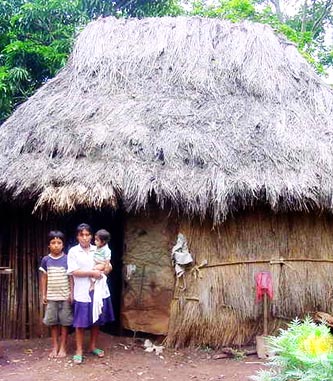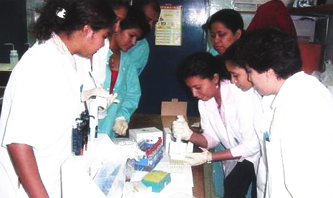Serodiagnosis KIT of Human Leptospirosis and Chagas Disease
What problem does it solve?
THE SERODIAGNOSIS KIT OF LEPTOSPIROSIS
Each year, there used to be more than a hundred deaths and common outbreaks of Leptospirosis in Nicaragua, with mortality rates of up to 1.5 for every 10,000 thousand inhabitants. At present, more than 10,000 people are tested each year using this reliable and quick system of diagnosis (results are available in 2½ hours).
The Serodiagnosis KIT of Human Leptospirosis solves the following problems:
• it prevents human deaths due to an illness, such as Human Leptospirosis, which is easily treated, through a cheap and versatile laboratory technique which provides prompt, reliable and quick diagnosis.
• it is a laboratory technique that provides early warning of Leptospirosis outbreaks in Nicaragua, and reduces loss of human life from this deadly illness. The KIT ensures that every person who is suspected of being infected by Leptospira spp bacteria, can be quickly and appropriately tested. This means that they receive prompt treatment (antibiotics), thus avoiding the complications that can cause death in a few hours or days.
• it increases diagnostic resolution levels in MINSA Health Units, which acquire the capacity to carry out epidemiological studies at the local and national levels, so that health authorities may have an up-to-date epidemiological characterization of the seriousness of the health problem that is represented by Human Leptospirosis in Nicaragua.
• reagents can be produced at the national level. Nicaragua is the only country in Central America which produces the Human Leptospirosis Diagnosis KIT and which has a functional network of laboratories providing early warning of outbreaks of the disease. In 2004, national supply was ensured by a production of 30 CNDR/MINSA LEPTO KITS, saving the country more than US$ 160,000.00 a year, the amount which would have been spent if the country had had to buy them commercially.
The innovation was first introduced in 2001, when a series of studies were carried out to reproduce, select and adapt strains of Leptospiras spp for artificial laboratory conditions. This provided the bases for sources of antigenic extracts from strains of Leptospira spp.
A second phase, spanning 2001 and 2002, involved standardizing and setting up production of ELISA (Enzyme-linked Immuno Sorbent Assay) KITS for the serodiagnosis of acute Human Leptospirosis. The technique presents intrinsic qualities such as: high diagnostic resolution (100% sensitivity and 99.6% specificity); quick laboratory results (2½ hours); simultaneous processing of several samples, since it is designed in strips that allow for the processing of between 1 and 96 samples at any one time; qualitative (colour intensity) or quantitative (ELISA readings) results; a cost that is 20 times lower than other similar techniques.
During the third stage, the technique was perfected in a standardized diagnostic KIT that can be reliably replicated by laboratory technicians working in MINSA health units. It was given the name CNDR/MINSA LEPTO KIT.
In 2002, national production of the CNDR/MINSA - LEPTO KIT enabled the Nicaraguan Ministry of Health, through the CNDR and the economic backing of the European Union, to decentralize the diagnosis of Human Leptospirosis through a network of 12 SILAIS (integrated local health care systems) and hospital laboratories, which carry out laboratory diagnosis and offer early warning of possible outbreaks of this illness.
THE SERODIAGNOSIS KIT OF CHAGAS DISEASE
In 1998, Nicaragua’s CNDR/MINSA laboratory for Medical Parasitology, with the economic backing of the World Health Organisation’s special program for Tropical Disease Research (TDR/WHO), began work which eventually led to the production of this KIT.
The CNDR/MINSA - Chagas Disease KIT is the result of more than five years research, which began with work to obtain local strains of Trypanosoma Cruzi from patients who had just caught Chagas Disease, adapting them to laboratory conditions and later using them as sources of antigens to standardize an ELISA (Enzyme-linked Immuno Sorbent Assay) type technique. Later this technique was perfected in a KIT for the diagnosis of Chagas Disease in its early acute and chronic phases.
The laboratory acquired the technical scientific know-how to isolate parasites from Chagas case patients, later adapting these national strains to artificial laboratory conditions. This provided the basis for the source of antigenic extracts, which later led to the preparation, standardization and production of this ELISA technique for the serodiagnosis of Chagas Disease.
The technique has the following intrinsic qualities: high diagnostic resolution (100% sensitivity and 98.4% specificity); quick laboratory results (2 hours); simultaneous processing of several samples, since it is designed in strips that allow for the processing of between 1 and 96 samples at any one time; qualitative (colour intensity) or quantitative (ELISA readings) results; a cost that is 8 times lower than other commercial techniques.
Having acquired a highly reliable ELISA diagnostic technique, in 2000, MINSA laboratories succeeded in perfecting it into a standardized diagnostic KIT, which can be readily replicated by laboratory technicians in all national health units. It was given the name CNDR/MINSA - Chagas KIT.
This technological advance enabled the Health Ministry, through to the CNDR and with the economic backing of TAIWÁN, to introduce, within in six months, the screening of Chagas Disease in 19 Blood Banks belonging to the SILAIS
(integrated local health care systems) of Madriz, Nueva Segovia, Estelí, Matagalpa, Jinotega, Boaco, León, Chinandega, Granada, Masaya, Carazo, Rivas, Río San Juan and the RAAS.
This process enabled more than 70,000 patients, whose lives depend on transfusions in these health units to receive blood that contained no hemoparasites which cause rapid illness and even death. The CNDR/MINSA - CHAGAS KIT is used to screen Chagas Disease in blood banks to prevent transmission of the disease through transfusions. By having this technique at their disposal, health units throughout the country can carry out on site diagnosis, epidemiological studies and assessments on the effectiveness of the treatment of Chagas patients.
The CNDR/MINSA - Chagas KIT solves the following problems:
• prevents the transmission of Chagas Disease through blood transfusions by screening blood donors, in accordance with Law no.369 concerning ‘transfusion security’ in Nicaragua.
• increases diagnostic resolution levels in national health system laboratories, providing them with a prompt diagnosis technique for Chagas Disease, which gives cheap, rapid, and reliable laboratory results, and which is accessible to the poorest sectors of the Nicaraguan population.








 COUNTRY OF ORIGIN
COUNTRY OF ORIGIN